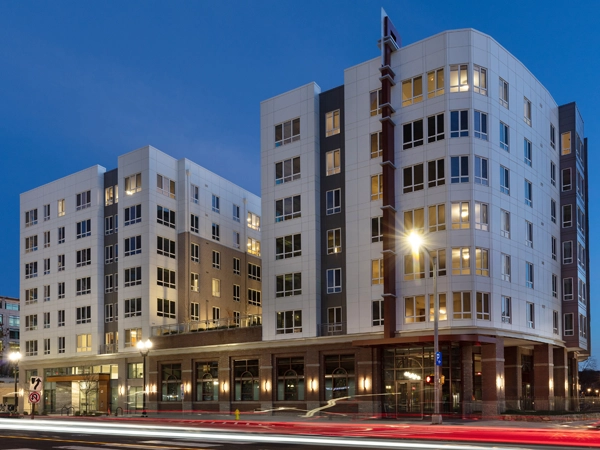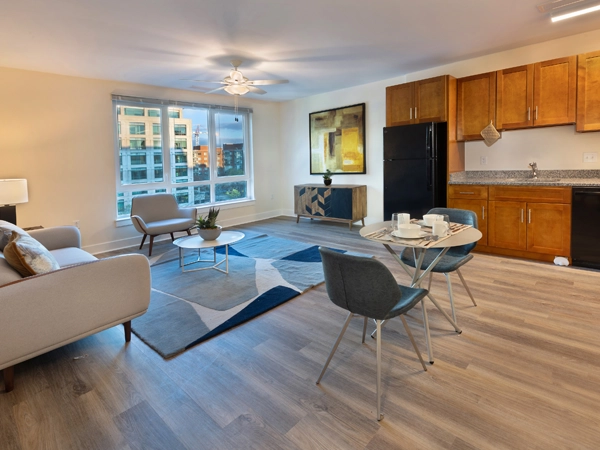In Arlington, Virginia, Faith Community Brings Affordable Housing
 Unity Homes offers 144 units of affordable housing in downtown Arlington, Virginia. Photo credit: True Ground Housing Partners
Unity Homes offers 144 units of affordable housing in downtown Arlington, Virginia. Photo credit: True Ground Housing Partners
Arlington, Virginia, a dense, affluent suburb of Washington, D.C., faces a pronounced shortage of affordable housing. Despite recent housing gains, low-income Arlington residents struggle to find affordable rentals, with only 12.2 percent of the rental housing stock affordable to households earning up to 60 percent of the area median income (AMI). Arlington's Ballston-Virginia Square neighborhood contains some of the densest census tracts in the Washington metropolitan area and has faced rising rents over the past 5 years, displacing lower-income households.
One success in addressing this challenge comes from a partnership between the Central United Methodist Church (Central UMC) and True Ground Housing Partners that led to the development of Unity Homes. Located near the center of Ballston, Unity Homes provides 144 units of affordable housing in a mixed-use development.
Mission-Driven Development
The 1-acre site that became Unity Homes has been the site of Central UMC since it was donated by the Ball family in 1906. The building was constructed in 1923 and expanded several times over the years. The congregation has prioritized serving the local community since roughly 2008, partnering with local nonprofits to offer free food to community members. In 2014, Central UMC set out to extend its service mission by developing affordable housing on the aging church property. The project team initially proposed a mixed-income property with 119 units for the site, but failed to secure low-income housing tax credit (LIHTC) financing. Complicating the development process was the site's small size and proximity to a Metrorail tunnel, regulatory and legal barriers related to the site's mixed-use services, and difficulties in securing financing.
Eventually, Central UMC partnered with True Ground (then called the Arlington Partnership for Affordable Housing), and the project was finally redesigned as an income-restricted affordable housing development. An increased loan contribution from Arlington County and a capitalized ground lease payment enabled the project to move forward despite the additional costs. The project broke ground in 2022 and opened in April 2024.
About Unity Homes
Unity Homes is in the heart of Ballston, across the street from a Metrorail station and regional transit hub serving dozens of bus lines and within walking distance of numerous employers, restaurants, and services. The development offers 144 units of affordable housing, including 33 one-bedroom, 24 two-bedroom, and 12 three-bedroom units available to residents earning up to 60 percent of AMI. An additional 60 one-bedroom units are available to residents earning up to 50 percent of AMI, and 15 one-bedroom units are reserved for residents earning up to 30 percent of AMI. The units feature large windows, spacious closets, and built-in kitchen appliances, including a microwave and dishwasher. In addition, approximately 10 percent of Unity Homes units are classified as permanent supportive housing.
 Income limits for most units at Unity Homes are set at 60 or 50 percent of the area median income. Fifteen units are reserved for residents earning up to 30 percent of the area median income. Photo credit: True Ground Housing Partners
Income limits for most units at Unity Homes are set at 60 or 50 percent of the area median income. Fifteen units are reserved for residents earning up to 30 percent of the area median income. Photo credit: True Ground Housing Partners
The mixed-use property consists of 175,500 square feet of residential space, including 53 parking spaces and 5,000 square feet of flexible community space. Amenities include an onsite laundry, a business center, and an outdoor courtyard with a green roof. Common areas and at least 12 units are accessible to people with physical disabilities.
Central UMC has retained roughly 34,100 square feet of condominium space, which includes the congregation's new sanctuary, music suite, commercial kitchen, fellowship hall, and expanded space for an existing daycare program. The new structure preserves 11 stained-glass windows from the original building and a Louis Comfort Tiffany stained-glass window, which Arlington County's public art and historical preservation departments reclaimed and made available for public viewing. Central UMC also runs an onsite daycare serving up to 100 children between the ages of 1 and 5 with 10 classrooms and 2 outdoor play areas.
Residents have access to a full-time onsite services coordinator who connects residents with resources according to each household's circumstances. Central UMC offers programming to support residents and the local community. Provision Church Catering operates the onsite commercial kitchen and offers meal distribution services. True Ground offers programming for residents focused on financial literacy, civic engagement, health and wellness, workforce development, and education.
Financing
Unity Homes was made possible through a combination of federal, state, and local funds as well as private fundraising and a capitalized ground lease payment. The $84.7 million project received $27.6 million in 4 percent LIHTC equity as well as $19.1 million from the Arlington County Affordable Housing Investment Fund and $12.8 million from Virginia Housing, including an $8.75 million Amazon REACH grant. A Central UMC capital campaign raised an additional $4 million. Other financing sources included $900,000 from the Virginia Housing Trust Fund, a $1.6 million deferred developer fee, and a $10.1 million seller note.
A Path to Success
Since Unity Homes opened, the development team has prioritized engaging with the local community. "[True Ground and Central UMC have] been intentional about reaching out to the community, hosting events that are open to the community," said Garrett Jackson, director of philanthropy and communications for True Ground.
The development team is optimistic about the continued capacity of faith-based development to help meet the need for affordable housing. "Unity Homes at Ballston is the result of a successful faith-based partnership that redeveloped church-owned land," said Carmen Romero, chief executive officer of True Ground Housing. "[This] is an innovative and replicable model in many communities across the country."
Arlington County. n.d. "Annual Affordable Housing Master Plan Report Fiscal Year 2023 Indicators." Accessed 3 January 2024; U.S. Census Bureau. 2019. "Selected Housing Characteristics." American Community Survey, ACS 5-Year Estimates Data Profiles, Table DP04. Accessed 3 January 2025; U.S. Census Bureau. 2023. "Selected Housing Characteristics." American Community Survey, ACS 5-Year Estimates Data Profiles, Table DP04. Accessed 3 January 2025; Payton Chung. 2021. "Which neighborhood in Greater Washington has the highest density? Hint: It's not in DC." Greater Greater Washington, 20 August. Accessed 3 January 2025. ×
Affordable Housing Finance. 2024. "Church and Housing Find Common Ground in Virginia," 22 April. Accessed 3 January 2024. ×
Document provided by Garrett Jackson, director of philanthropy and communications for True Ground Housing, 18 December 2024; Jen Tucci. 2024. "From Dreams to Reality," Central United Methodist Church, 12 May. Accessed 3 January 2025. ×
Document provided by Garrett Jackson, director of philanthropy and communications for True Ground Housing, 18 December 2024; Virginia Housing. 2022. "New, Affordable Housing Coming to Arlington," News, 21 March. Accessed 3 January 2025; Affordable Housing Finance. 2024. "Church and Housing Find Common Ground in Virginia," 22 April. Accessed 3 January 2025. ×
Document provided by Garrett Jackson, director of philanthropy and communications for True Ground Housing, 18 December 2024. ×
Document provided by Garrett Jackson, director of philanthropy and communications for True Ground Housing, 18 December 2024. ×
Document provided by Garrett Jackson, director of philanthropy and communications for True Ground Housing, 18 December 2024. ×
Document provided by Garrett Jackson, director of philanthropy and communications for True Ground Housing, 18 December 2024; Provision Church NOVA. n.d. "Our Story." Accessed 3 January 2025. ×
Document provided by Garrett Jackson, director of philanthropy and communications for True Ground Housing, 18 December 2024; Virginia Housing, 2022. "New, Affordable Housing Coming to Arlington," news, 21 March. Accessed 3 January 2025. ×
Interview with Garrett Jackson, 19 December 2024. ×
Document provided by Garrett Jackson, 18 December 2024; Email communication with Garrett Jackson, 19 December 2024. ×
